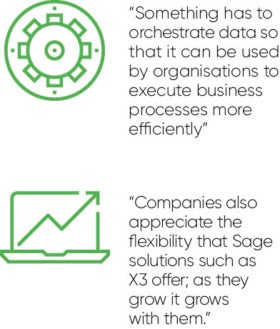 Fragmented systems and outdated ways of managing data mean British manufacturing is failing to take advantage of the opportunities on offer from the industrial internet of things IIoT), often because business leaders do not understand the need to invest in new technology, according to David Watts, Sage UK and Ireland enterprise vice president.
Fragmented systems and outdated ways of managing data mean British manufacturing is failing to take advantage of the opportunities on offer from the industrial internet of things IIoT), often because business leaders do not understand the need to invest in new technology, according to David Watts, Sage UK and Ireland enterprise vice president.
Enterprise resource planning (ERP) has revolutionised the way in which organisations are managed. Increased data has become more readily available and manual systems have been automated, saving time, reducing costs and minimising human error. But now ERP is itself being revolutionised by the arrival of the industrial internet of things.
Andrew Spence, UK and Ireland solution consulting director at Sage, the market leader in business management systems, says these innovations combined provide an opportunity to manage suppliers, purchases, resources, employees and customers more effectively than ever.
“The industrial internet of things is about connecting machines and people, and creating large volumes of data,” he says. “But something has to orchestrate that data so it can be used by organisations to execute business processes more efficiently, such as ERP. It’s the central nervous system of an organisation.”
He points out that machines have been talking to each other for decades, but recent years have seen accessibility via mobile increase significantly. “Everyone now has a mobile device whether they’re providing, sourcing or viewing information and this improved connectivity has been a massive driver for ERP.”
However, many companies are still missing out on the benefits offered by this new world of IIoT-enabled ERP. “Most manufacturing businesses in the UK struggle because of fragmented systems that don’t talk to each other,” says Mr Spence. “Information is entered and transferred manually, meaning that it’s often out of date or incorrect.”
This very often comes down to misperceptions of the cost of technology and a limited view of its role. He says: “Although cost is a major factor for consideration, we also need to educate the leaders of our manufacturing organisations so they understand that technology can be used as an enabler for developing new business and improving outcomes.”
Rather than seeing software as an end in itself, business leaders should regard it as a provider of information that they can use to improve their business. They might invest in expensive machine tools, but often these investments don’t follow through into their business systems.
“If you buy a new machine tool, it’s very easy to justify it with a cost-benefit analysis, but the calculation is more complex with an end-to-end business process. You need confidence and a more strategic way of thinking,” says Mr Spence. Businesses also need to consider the “soft” benefits such as improved customer service and management of suppliers.
This strategic view is one reason why a growing number of companies are looking to Sage for an ERP system that is ready for the changes the IIoT is introducing.
“Our payments, payroll and people systems are pervasive in most organisations, but now we’re really driving innovation with the breadth of the capability of our ERP platform and its connectivity,” says Mr Watts. “You can connect devices to our ERP systems. Everything from interacting with customers to paying suppliers can be done in a seamless process.”
Available as a public cloud, privately hosted cloud or on-premise solution, Sage X3 is accessible from any device, and is scalable for growing and global businesses due to its flexibility.
The architecture of X3 is constantly being updated to handle increased volumes of data and speed of use, says Nana Fifield, head of product development, X3 manufacturing, at Sage.
“We’re improving user experience and the ability to bring out useful insights from data,” says Ms Fifield. “We’re looking at how we can take real-time data and integrate it into X3, so customers have all the information that ERP offers at their fingertips.”
Everything from interacting with customers to paying suppliers can be done in a seamless process
As an example of a true smart supply chain, Ms Fifield points to retailers that are introducing smart shelves to provide real-time information on stock levels. Similarly, medical services can use monitoring and mobile devices to enable faster testing and data analysis of patients before ordering drugs and treatments accordingly.
“With the next-generation supply chains offering end-to-end visibility and control, Sage X3 will be able to take orders for parts and products and, using the power of devices and other forms of data, it will be able to make decisions about different transport options by proactively monitoring environmental conditions and cost factors,” she says. “These supply chains will also be able to access data from products on the ground to see how machines are responding to environmental conditions.”
As businesses come to terms with the practicalities of Brexit and the risk of increased regulation, X3’s global reach means it’s already prepared for these challenges.
In this world of faster and more unpredictable economic and political change, X3 benefits from the agility and flexibility offered by the cloud to develop automation and robotics more quickly, bringing solutions to market much faster and receiving customer feedback more rapidly. It also allows companies to update their legacy systems in line with their budgets and other constraints.
When Sage unveiled the innovations offered by X3, the company was taken aback by the response. “People were telling us they were suddenly aware of what X3, in conjunction with the IIoT, could offer them,” says Ms Fifield. “We had clients from sectors as varied as manufacturing, sales, pharmaceuticals and agriculture, who could suddenly see the benefits of the IIoT integrated with ERP to their businesses. It was a revelation, but only a taste of things to come.”



